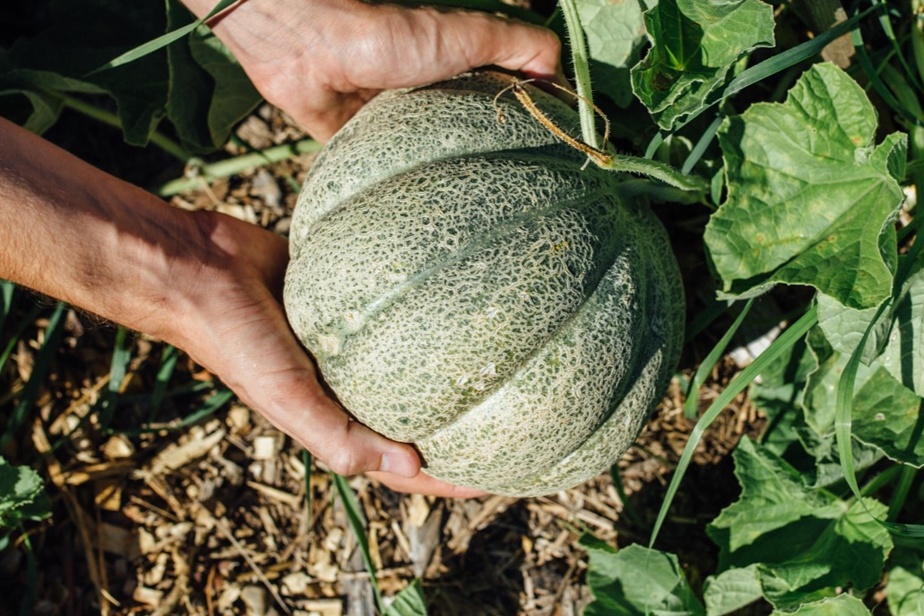For months, nutritionist Bernard Lavallée dug up all the information he could find on a melon grown more than 100 years ago in Montreal. From this obsessive quest, which transformed him into a hermit, emerges a box of seeds to cheerfully spread so that the past is not forgotten.
For several years, Bernard Lavallée has been assembling boxes of ancestral fruits and vegetables “for fear that they will disappear and be forgotten,” he says. In 2022, he also published In defense of diversitya book tracing the plants and animals that nourished our ancestors before disappearing forever.
“It’s an obsession underlying many of my projects,” emphasizes the man also known as the Urban Nutritionist. Among all these once glorious species, he has a particular affection for the Montreal melon which is, according to him, the emblem of a diet belonging to the past.
“It made me realize that overnight, everything you eat can disappear,” says the author. By going back to the sources, I discovered that no one really knows the origins of the stories we tell. » So he went through lots of seed catalogs and dusty boxes to unearth its history. Thus, what was supposed to be a packet of seeds accompanied by a small booklet became a book which, to date, is the most complete story told about this mythical fruit.
In search of wasted time
Bernard Lavallée fell into a vortex, caught up in his quest to the point of creating a void around him and working from morning to evening without being able to stop. It must be said that the story of this melon, said to be like no other, is fascinating. It is said that at the turn of the 20th centurye century, the wealthy paid a tidy sum to enjoy a single slice. Sold for $2.50 in 1922, this green-fleshed muskmelon would be worth $43.15 today!
Of this fruit, served in luxury establishments in the city and as far away as New York, we know that it had succulent and fragrant flesh, without further details.

PHOTO MARTIN CHAMBERLAND, LA PRESSE ARCHIVES
Bernard Lavallée
It’s fascinating to think that barely 100 years ago, a fruit so precious was grown in Montreal that it contributed to the city’s fame and that today, the majority of people do not care about it. have never heard of it.
Bernard Lavallée, nutritionist
Indeed, the enthusiasm surrounding the Montreal melon began to fade in the 1920s. One of the reasons being that its producers sold their land for the construction of highways and houses, specifies the author.
The abandonment of its culture caused its disappearance, until a journalist from the daily The Gazette, Mark Abley, became interested in it in 1991 and got his hands on a bag of old seeds in a preservation bank in Iowa. A few years later, the great return of the Montreal melon was announced. But is it really the right one?
Rediscover the taste of yesteryear
Many people have expressed doubts about the veracity of this new Montreal melon. According to the archives, no other melon would reach its peduncle! Period photos also show large format specimens. However, when cultivating it, some found it to have an ordinary taste and modest dimensions. Disappointment.
“My research allowed me to understand that even at the time, we had melons of different sizes: there were small ones, medium ones, large ones,” argues Bernard Lavallée. As for flavors, some specimens don’t taste as good, but others are really interesting. »
Right now, we probably need to reselect the variety to get back the taste of yesteryear. This is what we are trying to do with this project, hoping that lots of people will cultivate it so that it becomes exceptional again.
Bernard Lavallée, nutritionist
Would the Montreal melon have been put on a pedestal at the time in advertisements produced by those who wanted to sell it? Quite possible. Having tasted it and having grown it himself in his street, Bernard Lavallée nevertheless believes that the best specimens have “a distinct taste that is worth it”.
With no data allowing us to compare the genetics of the new specimens to the old ones, we will probably never be able to confirm that these are indeed the seeds of the fruit that fueled the legend. But is it so relevant? asks Bernard Lavallée. “If we are able to grow melons that taste good, that have a respectable size and that, in addition, allow us to tell this story, I think it’s a winner. »
This is the emotional response. From a scientific point of view, it is a diversity of genetic baggage with which we can work to develop new varieties in the future, he also argues. Some ancestral varieties are resistant to diseases, insects or drought. “It is important to preserve this Quebec food heritage, an intangible wealth that we must not forget. »
Getting your hands on the earth for heritage

PHOTO PROVIDED BY THE URBAN NUTRITIONIST
The Montreal melon growing kit
Bernard Lavallée collaborated with the seed company Louis-Philippe Mailloux, of Semences Nouveau Paysan, to create theCrop set. Out of hundreds of Montreal melons grown by the seed company, the best seeds were saved for this box project which includes a book and a packet of seeds. “I dream that lots of people in Quebec will take part in this experience,” confides the author who is organizing a friendly competition for the biggest melon in Montreal. The challenge is launched. The Montreal melon box is sold on the Urban Nutritionist online store, at a price of $29.
Visit the Urban Nutritionist website
